Related Research Articles

Johann Georg Albrechtsberger was an Austrian composer, organist, and music theorist, and one of the teachers of Ludwig van Beethoven. He was also a friend of Haydn and Mozart.
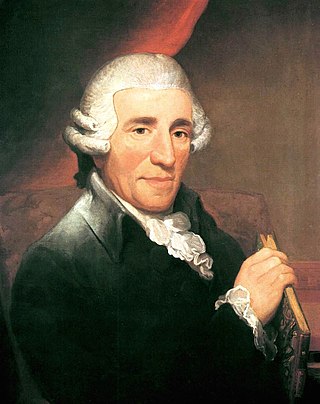
Franz Joseph Haydn was an Austrian composer of the Classical period. He was instrumental in the development of chamber music such as the string quartet and piano trio. His contributions to musical form have led him to be called "Father of the Symphony" and "Father of the String quartet".
Johann Evangelist Haydn was a tenor singer of the classical era; the younger brother of the composers Joseph Haydn and Michael Haydn. He was often called "Hansl", a diminutive form of "Johann".

Symphony No. 22 in E♭ major, Hoboken I/22, is a symphony written by Joseph Haydn in 1764, under the auspices of the benign Prince Nikolaus Esterházy. Its nickname is "The Philosopher".

Joseph Haydn's Symphony No. 13 in D major was written in 1763 for the orchestra of Haydn's patron, Prince Nikolaus Esterházy, in Eisenstadt.

Eisenstadt is the capital city of the Austrian state of Burgenland. With a population of 15,074, it is the smallest state capital and the 38th-largest city in Austria overall. It lies at the foot of the Leitha Mountains hill range.

The House of Esterházy, also spelled Eszterházy, is a Hungarian noble family with origins in the Middle Ages. From the 17th century, the Esterházys were the greatest landowner magnates of the Kingdom of Hungary, during the time that it was part of the Habsburg monarchy and later Austria-Hungary. During the history of the Habsburg Empire, the Esterházy family was consistently loyal to the Habsburg rulers. The Esterházys received the title of Graf (Count) in 1626, and the Forchtenstein line received the title of Fürst (Prince) from the Holy Roman Emperor in 1712.

Adamus List was the father of composer and pianist Franz Liszt.
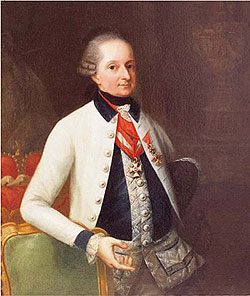
Nikolaus I, Prince Esterházy was a Hungarian prince, a member of the famous Esterházy family. His building of palaces, extravagant clothing, and taste for opera and other grand musical productions led to his being given the title "the Magnificent". He is remembered as the principal employer of the composer Joseph Haydn.

Eszterháza is a palace in Fertőd, Hungary, built by Prince Nikolaus Esterházy. Sometimes called the "Hungarian Versailles", it is Hungary's grandest Rococo edifice. It was the home of Joseph Haydn and his orchestra from 1766 to 1790.

Theresienmesse is a mass in B-flat major written by Joseph Haydn and named after Maria Theresa of the Two Sicilies, empress consort of Francis II. The empress herself was the soprano soloist at private performances of both The Creation and The Seasons in May 1801 at the Viennese Court. The title does not appear on the autograph score, which is labeled simply with the Latin word "Missa".
Gregor Joseph Werner was an Austrian composer of the Baroque period, best known as the predecessor of Joseph Haydn as the Kapellmeister of the Hungarian Esterházy family. Few of Werner's works survive to the present day, and he is mostly remembered for his troubled relationship with Haydn.

Joseph Haydn's Symphony No. 31 in D major, Hob. I/31, was composed in 1765 for Haydn's patron Nikolaus Esterházy. It is nicknamed the "Hornsignal Symphony", because it gives a prominent role to an unusually large horn section of four players. Probably because of its prominent obbligato writing for the horns, in Paris, the publisher Sieber published this symphony as a "symphonie concertante" around 1785.

Joseph Haydn's Symphony No. 29 in E major, Hoboken I/29, was written in 1765, just after his 28th, and to be performed in Eisenstadt, under the benign auspices of Prince Nikolaus Esterházy.
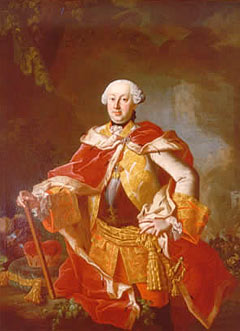
Prince Paul II Anton Esterházy de Galántha was a Hungarian prince, soldier and patron of music from the Esterházy family.
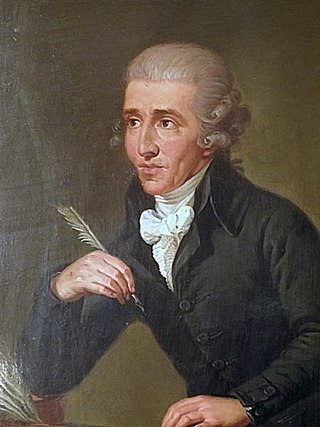
The Missa brevis Sancti Joannis de Deo, Hob. XXII:7, Novello 8, is a mass in B-flat major by Joseph Haydn. The missa brevis was written around 1775 for the order of the Barmherzige Brüder in Eisenstadt, whose patron saint was John of God. Scored modestly for soprano, four-part mixed choir, two violins, organ and bass, it is known as the Kleine Orgelmesse due to an extended organ solo in the Benedictus movement which also includes the only featured solo voice - a soprano.
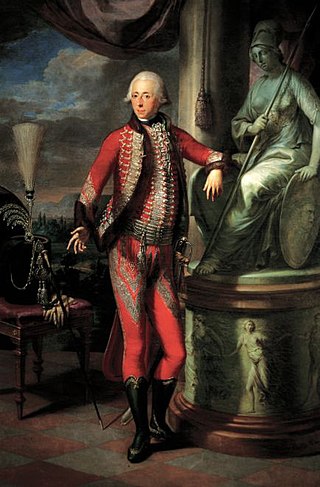
Nicholas II, Prince Esterházy was a Hungarian prince. He served the Austrian Empire and was a member of the famous Esterházy family. He is especially remembered for his art collection and for his role as the last patron of Joseph Haydn.
Luigi Tomasini was an Italian violinist and composer. He was leader of Prince Esterházy's court orchestra, which was directed by Joseph Haydn.
References
- ↑ "Novotný, Franz Nikolaus" by Camillo Schoenbaum, Grove Music Online (subscription required)
- ↑ "Novotny, Franz Nikolaus: Small Preludes for Organ". Archived from the original on 2011-10-04. Retrieved 2010-08-07.